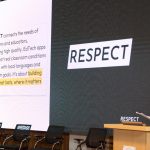October 11, 2021
In this article Elizabeth S. LeBlanc, co-founder and CEO of the Institute for Teaching and Learning, discusses the impact of the pandemic on the future of education and work and provides several predictions for the road ahead.

The Future of Education and Work
The worldwide COVID-19 pandemic has forced a massive re-evaluation of learning systems worldwide, altering the educational landscape for teachers, school and district leaders, edtech companies, entrepreneurs, parents, and students alike. But what will COVID-19 ultimately mean for the future of school and work?
Proving once again that invention is often born of necessity, the field of global education technology over the past year has created, implemented, and executed a rapid-fire series of solutions designed to keep adult and youth learners connected to their ongoing schooling. New education models arose and evolved as the circumstances of pandemic education changed – emergency remote learning, virtual instruction, webinars, self-paced modules, online classes, part-time blended learning, small group hybrid models, learning pods, and community lab schools have all become a part of our expanded educational experience over the past year. The swiftly growing vocabulary and terminology of the industry reflects the exponential expansion of the how, where, and when of PreK-12, postsecondary, and professional education both in the classroom and in the cloud.
The US-based Institute for Teaching and Leading (i4tl) has supported schools and districts as well as state and national departments of education in rethinking “education as usual” in the wake of the pandemic. Our organization works to create more equitable, student-centered learning experiences, which gives us a unique view to the changes that are, and are not, happening at scale. Based on our conversations with educators and entrepreneurs alike across the globe (and with a healthy dose of optimism!), here are our predictions for the “future of school and work” as we move to envisioning post-pandemic education:
Prediction 1: Virtual learning is here to stay (and it’s getting better).
Across the globe, schools from Wuhan to Washington, from early childhood centers to institutions of higher learning, were forced into a sudden transition from in-person learning to complete reliance on technology-mediated school-in-the-cloud. As with anything new, the field of edtech learned a lot along the way about what works for schools, teachers, students, and families, and how to juggle those sometimes competing needs. When done well, virtual learning can accommodate increased flexibility in terms of:
- pacing that allows learners to engage where and when it works best for them;
- personalized instead of one-size-fits-all learning, in which professionals and pupils alike can benefit from customized instruction that moves them towards their identified goals; and
- greater learner agency as students of all ages are allowed greater autonomy, voice, and choice over their continued education.
One particularly surprising element of pandemic education is the number of students who – much like adults who choose the flexibility, freedom, and independence of remote work or a work-from-home model – not only survived, but thrived in the virtual setting. Even when health guidelines no longer dictate the necessity of virtual engagement as an option offered by all schools or companies, it is hard to imagine those students and professionals will happily move back to the status quo. Similarly, virtual learning has become an increasingly critical part of industry and corporate training across multiple sectors, with many companies building customized, self-paced, on-demand learning modules. These in-house programs are largely designed to build internal capacity and increase employee skills, even during times when employees may not be on-site. We predict that there will be a non-negligible percentage of students and professionals alike who come to rely on, and indeed demand, the flexibility of virtual options – both in the school space and the work space.
RECOMMENDED: https://global-edtech.com/category/edtech-market/
Prediction 2: More schools and businesses will provide flexible learning pathways that result in milestone credentials along the way.
While technology is often seen as the driver of creating more individualized learning programs that can meet students where they are, in reality, it is the accelerant. High-quality, edtech tools are what allow educators to scale deeply personalized learning that reaches every student – and the future of both school and work will rely on these tools to level the playing field across a diverse range of needs. For the educational sector, meeting the needs of students who may re-enter the classroom ahead of their peers in some areas yet behind in others, and addressing their social-emotional learning needs simultaneously means that teachers and schools will need to radically rethink how, where, and when they leverage instructional technologies, with the goal of letting digital tools take care of the tasks that technology can best accomplish, while freeing up human capital to do those things that technology cannot accomplish for our students.
In terms of adult learning, we anticipate more opportunities across training programs, higher education, or in-house staff development for professionals to engage in learning pathways that align with their career goals, helping these learners build the skills needed for advancement and/or diversification of skill sets. Increasingly, we are seeing that these programs result in industry-recognized nano- or micro-credentials that are stackable, affordable, and transferable, with a focus on the ability to quickly upskill or to swiftly pivot a set of existing skills into a new work setting. Across both sectors, relational learning is more, rather than less, important in a post-pandemic environment. Cultivating strong relationships with students, creating mentorship programs that support and sustain emerging learners and professionals, and building deliberately inclusive networks will all become part of the baseline rather than the exceptions of educational and professional life.
Predication 3: The future of education and work will demand agility and creative problem-solving over memorization.
As our industry slowly enters a post-COVID world, the i4tl team has found themselves coaching increasing numbers of teachers, schools, and districts – as well as national and international organizations – on how to leverage the lessons learned over the past year. For many, these lessons have oriented around flexibility, intense resource reallocation, and the ability to adjust rapidly to changing conditions without breaking the things that are working well. Similarly, these lessons reinforce the ascendance of the same values that helped us navigate pandemic even after it is over.
In a PreK-12 context, as a field, we see a huge move to an “engagement over compliance” mindset in some ways necessitated by pandemic teaching and learning. Whereas in the brick-and-mortar classroom, a teacher can construct more hands-on, project-based demonstrations of learning, with the quick shift (and subsequently little time to prepare), many teachers struggle to translate the same experience into cloud-based instruction. While virtual learning tools can be used to deliver content at their most basic level, if students and employees are only asked to return the information they receive as they found it, true learning has not occurred. PreK-12 teachers and leaders often come to us concerned that their students can simply Google their way to the correct answer, but if that is the case, then the mode of assessment and the yardstick itself needs to be reevaluated. Thus, we predict the rise of creativity over rote memorization, with a greater emphasis on what students can do and create with the information learned versus what they can simply recall.
For professional learning contexts, the role of context and application will also become more important. Rather than simply having earned the micro-credential or completed a development task, adult learners and professionals will increasingly be expected to have then created something new and different with that information; this is part of a larger shift from the student-as-content-consumer to the student-as-content-producer and a contributor to the furtherance of their field. More companies are building performance tasks based on the nature of the job into their hiring processes and practices.
Looking Ahead:
As we begin to unpack the many ripple effects of the global pandemic in reshaping the future of both school and work, we are excited to enter a more accessible, equitable, and creative education landscape that is oriented to better serve all learners.
BIO:
Elizabeth S. LeBlanc is the co-founder and CEO of the Institute for Teaching and Learning, a company that offers education consulting, professional learning, and education research services. She also serves on the board of the nonprofit Center for Research and Innovation which focuses on digital equity, rural education, and scaling impact to state, national and international contexts. In addition, Ms. LeBlanc currently serves as the Director of Teaching and Learning at Taos Academy Charter School, a small innovative blended learning school in northern New Mexico, USA.
New to EdTech? Read our EdTech 101 guide: https://global-edtech.com/edtech-definitions-products-and-trends/








